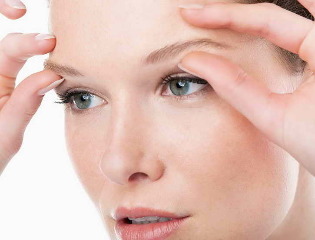
The eyelid lift is a complex of hardware, injection and manual manipulations that aim to rejuvenate and shape the periorbital area (the area around the eyes). This part of the face is considered a zone of greater sensitivity, therefore, non-surgical aesthetic eyelid correction is a difficult task, even for a highly qualified specialist with extensive experience. Microsurgical cosmetology and aesthetic medicine today offer several effective methods of lifting the eyelids: radio wave lifting, bio-reinforcement with threads, contour plastics, photorejuvenation, microcurrent therapy. You can choose the most appropriate technique only after a visual examination of the problem area, studying the patient's medical history, his goals and ideas about what the final result should be.
Peculiarities of the periorbital survey
The eyelid region, also called the periorbital zone (which is not entirely true, as the lacrimal apparatus, the eyelid cleft and the conjunctival sac also belong to the periorbital space, in addition to the eyelids), is one of the most sensitive areasof the human body with a thin layer of dermis and minimal subcutaneous fat. The eyelids are musculocutaneous folds, later bounded by conjunctival and cartilaginous tissue. They are located around the eye and perform several functions at the same time: they protect the cornea and retina from the negative effects of environmental factors (ultraviolet radiation, dust, etc. ), clean the connective tissue membrane due to constant wetting with fluidlacrimal,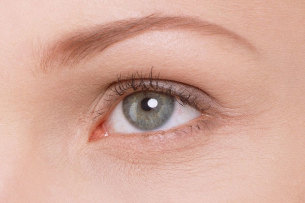 prevent dryness of the eye sclera and the cornea.
prevent dryness of the eye sclera and the cornea.
The skin of the eyelid region is several times thinner compared to other parts of the face, so it is more prone to stressful and age-related changes, which in most people become noticeable after age 30. At that age, the body's natural dehydration process begins, with which the epidermal cells lose moisture and the skin loses elasticity, becomes flabby and flabby. It is in the periorbital zone in men and women over 30 years old that the first signs of aging are formed: hypodynamic folds, mimicking wrinkles, creases in the outer corners of the eyes ("crow's feet").
Lifting the eyelids is a complex task that should only be performed by a highly qualified physician with excellent knowledge of the topographic anatomy of the eye, as inappropriate actions can not only cause new defects, but also seriously impair the function of the eyes. organs of vision. The fact is that the eyelids are involved in the formation of the ocular focus and in the optical geometry of the cornea, as well as in the regulation of intraocular pressure, therefore, plastic surgeries and inadequate surveys performed can cause a disturbance of visual function (in some cases, irreversible).
Who needs eyelid lifting
Elevation of the periorbital zone has no strict medical indications (except for surgical correction, which is often used to treat conditions that interfere with the normal functioning of the organs of vision) and is usually performed at the patient's request to eliminate visible aesthetic defects. Cosmetologists and plastic surgeons include the following defects in such disadvantages:
- strong protrusion of the supraorbital fold;
- excess skin in the infraorbital musculocutaneous fold;
- drop in the outer corners of the eyes;
- periorbital protrusions (fatty hernias);
- periorbital edema (bags);
- vascular pathologies that lead to the appearance of traces of rosacea and dark circles;
- hypodynamic wrinkles;
- "crow's feet" (creases in the corners of the eyes);
- strongly pronounced infraorbital grooves;
- "aging of the eyelid" (withered and sagging eyelid skin).
The lifting of eyelids also helps to make the appearance fresher and more open, correcting protruding skin and bags of periorbital fat and improving the overall tone of the area.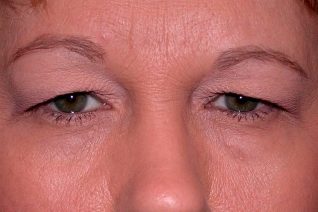 The timely use of various methods of rejuvenating the area around the eyes helps to solve one of the main tasks of periorbital lifting - hiding age-related changes in the skin and getting rid of the visual defects characteristic of biological dermis aging in the contexta decrease in the functional potential of epidermal cells.
The timely use of various methods of rejuvenating the area around the eyes helps to solve one of the main tasks of periorbital lifting - hiding age-related changes in the skin and getting rid of the visual defects characteristic of biological dermis aging in the contexta decrease in the functional potential of epidermal cells.
Important! Aging and heavy eyelids are a serious cosmetic flaw that can ruin even a young, attractive face. For some, signs of skin aging in this area may appear before the age of thirty (for example, in patients with low weight or in a person with pathologies of the endocrine system). As a rule, cosmetics are ineffective to correct existing problems and are only suitable for preventing premature aging; therefore, the only effective method of dealing with this defect is periorbital lifting.
Eyelid Lifting Surgery
An operation to lift the skin on the upper and lower eyelids is called blepharoplasty. It is a kind of radical lifting of the periorbital zone, in which the effect of tensioning and rejuvenation is obtained by completely removing the excess skin and fatty hernias from the eyelid region.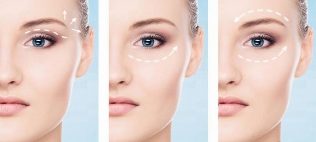 Contrary to non-surgical methods of lifting eyelids, blepharoplasty allows not only to correct defects in aged skin and improve the appearance of this area, but also to correct the shape and shape of the eyes, as well as to eliminate various pathologies.
Contrary to non-surgical methods of lifting eyelids, blepharoplasty allows not only to correct defects in aged skin and improve the appearance of this area, but also to correct the shape and shape of the eyes, as well as to eliminate various pathologies.
Blepharoplasty is effective for severe ophthalmic diseases such as entropion (protuberance of the eyelashes and the edge of the eyelid towards the eyeball) or exophthalmos (displacement of the eyeball outside the orbit). In total, there are three types of blepharoplasty: upper, lower and circular.
Table. Types of radical periorbital survey
| Type of operation | Section area | What pathologies can be corrected |
|---|---|---|
| Supraorbital blepharoplasty | An incision in the skin that is made along the orbital or tarsal fold of the upper eyelid. | Removal of excess skin, subcutaneous fat and muscle plastic. |
| Suborbital blepharoplasty | A transcutaneous or subciliary incision is made. | Removal of periorbital edema, bags under the eyes, fatty hernias. |
| Circular blepharoplasty | Simultaneous eyelid surgery on both sides. | Solving problems common to all types of blepharoplasty. |
The tightening operation of the periorbital zone occurs strictly in a hospital environment, excluding the possibility of an outpatient procedure. The patient receives general anesthesia, and the duration of the intervention is, on average, about 3 hours. A significant disadvantage of this method of lifting the eyelids is the post-operative period, which, although short in duration (about two weeks), is characterized by pain, the need for regular dressing and antiseptic treatment and significant restrictions on the regimen andProfessional activities.
Important! The advantage of surgical blepharoplasty is the ability not only to tighten the skin of the eyelids, but also to perform plastic surgery on the muscle tissue, which cannot be done with hardware and other minimally invasive methods.
Tightening of the periorbital zone without surgery
Surgical lifting of the eyelids is a highly effective method of radical rejuvenation of the area around the eyes, but experts advise resorting to it only for patients in the older age group (after 40 years) with pronounced signs of aging andprofound age-related skin changes. Before reaching this age, while the hydrodynamics of the tissues are within the normal range, there are many less traumatic ways to correct existing problems, and the effectiveness of most of these techniques in some cases can be compared with the result of surgical plastic surgery.
Injection plastic (contour)
The contour plastic is perhaps the safest method of non-surgical lifting of the eyelid skin, according to the technique that belongs to the mesotherapeutic procedures. The contour is a subdermal injection of special implants called fillers.
These are preparations in the form of suspension or homogeneous and viscous gel, based on components with a high degree of affinity for the body's own tissues. They can be:
- hyaluronic
- acid; calcium hydroxyapatite;
- collagen (peptide synthesized by fibroblasts and which is one of the main elements of the dermis extracellular substance, which guarantees its elasticity and elongation capacity);
- polymers based on acrylic and methacrylic acid;
- high molecular weight oxygenated silicone; polylactic acid
- ;
- salts of tripolyphosphoric acid, etc.
The most popular and required fillers for periorbital lifting are hyaluronic acid preparations. They are biodegradable dermal implants (absorbable), which not only compensate for the tissue deficiency in this area, but also help to eliminate wrinkles - one of the main visual signs of facial aging. The advantages of hyaluronic fillers include high hypoallergenicity and excellent results, which can be seen immediately after implantation. Hyaluronate bioresorption occurs within several weeks, after which injections must be repeated.
Biosynthetic implants based on polylactic acid and calcium hydroxyapatite maintain their properties for 1-2 years.
RF elevation
Lifting by radio waves or radiofrequency is a non-surgical procedure to lift the area around the eyes with a high degree of effectiveness.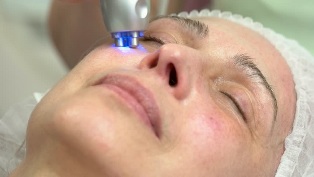 Among the hardware techniques for minimally invasive lifting of the skin of the upper and lower eyelids, the RF lift assumes a leading position, since it allows not only to achieve an immediate tightening effect, but also significantly improve the conditionof the skin in the periorbital zone.
Among the hardware techniques for minimally invasive lifting of the skin of the upper and lower eyelids, the RF lift assumes a leading position, since it allows not only to achieve an immediate tightening effect, but also significantly improve the conditionof the skin in the periorbital zone.
The radio waves, penetrating the dermis to the required depth, heat the epidermal cells to the temperature of collagen densification, which is about 60 ° C. Under the influence of thermal energy, the dermal tissue heats up, occursa partial retraction of the collagen structure, with which the loose collagen fibers shrink again and assume their characteristic spiral shape, which is the lifting effect.
The RF survey is suitable to correct all age-related problems in the area around the eyes (crow's feet, hypodynamic wrinkles, eyelid ptosis, etc. ), and the result obtained lasts up to 1-2 years. To achieve a stable rejuvenating effect, you will need to perform about 6 to 10 procedures with an interval of at least 7 to 10 days.
Wired bio-reinforcement (wire lifting)
The lifting of the threads is a rejuvenation procedure for the eye region, which is based on the implantation of special cosmetic threads made of various metals and synthetic materials under the skin, resulting in the formation of a new collagen skeleton in the subdermal layers. The procedure is very effective and allows you to face the problem of “aging the eyelid”, periorbital fatty hernias, the phenomena of gravitational ptosis and other phenomena characteristic of skin aging.
There are several types of threads for lifting threads. Threads made of precious metals are highly sought after in cosmetology. These strands are made of platinum or gold and are designed to reinforce the upper layers of the dermis. The golden threads not only provide a visible lifting effect, but also stimulate cellular metabolism, improving the supply of nutrients, oxygen and vitamins to the dermal cells. The serious disadvantages of precious metal wires are the high risk of detachment and the impossibility of many cosmetic procedures, for example, photothermolysis after reinforcement.
Liquid mesothreads are mainly used to combat small hypodynamic folds, correct “eyelid aging” and smooth the skin in the periorbital area. The duration of this procedure does not exceed 20-30 minutes, but the reinforcement with liquid threads has many contraindications and is always accompanied by several side effects (swelling, bruising, redness). Experts believe that the most effective type of lifting eyelid strands is Swiss, polylactic and Korean strands. The result after this reinforcement lasts about 2-3 years.
Fractional photothermolysis
Fractional photothermolysis is another effective method of non-surgical contraction of the skin of the upper and lower eyelids. This is a type of laser rejuvenation in which a fractional laser generator (for example, an erbium laser) is used to influence the problem area. The beam generated by this device is spread in many streams and, when it reaches the skin, forms a large number of microthermal healing zones, in which the main effect occurs, so that the surrounding tissues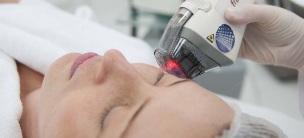 do not heat up and are not injured.
do not heat up and are not injured.
A distinctive feature and at the same time the main principle of action of fractionated photothermolysis is to heat the skin to a temperature of 250-300 ° C, which experts call the evaporation procedure. Old cells, pathologically altered and destroyed under the influence of this temperature are destroyed and evaporated, while the natural neocolagenesis is activated and the activity of fibroblasts increases, which synthesize the main components of the extracellular matrix - the peptides (collagen and elastin).
The result of fractional laser resurfacing is a remarkable stiffening of the skin on the eyelids, smoothing out wrinkles and creases, restoring the hydrodynamics of the periorbital tissues and improving the general condition of the skin in that area.
Wrist chains (microcurrents)
Microcurrent therapy refers to less traumatic methods of lifting the eyelids, but a significant disadvantage of this method is the short duration of the result (no more than 4 months). The clinical result of using microcurrent therapy to elevate the periorbital zone is due to the following properties of impulse currents:
- normalization of the lymphatic flow.Effect of lymphatic drainage, which has impulse currents in the skin, improves the movement of the lymph, prevents its stagnation and helps to lighten dark circles;
- stimulation of metabolic processes.The activation of cellular metabolism has a positive effect on the transport of oxygen and nutrients and on the appearance of the skin (the skin becomes smooth, acquires a healthy appearance);
- restoration of muscle tone.The eyelid muscles are quite weak and the additional stimulation allows for a contraction effect.
The standard course duration is 10 to 20 procedures, although in most cases it is necessary to repeat the procedure after a few months.

Before and after photos
Conclusion
Lifting the eyelids is a difficult but viable task, for which modern aesthetic medicine offers a large number of effective methods, including less traumatic manipulations with a low probability of complications. Which periorbital survey method will be the most effective and safe is individually decided after talking to the patient, diagnosing the problem area and studying the medical history data.
The use of surgical techniques is mainly indicated for patients with marked signs of aging in the area around the eyes, in which the use of mild techniques is ineffective and presumably will not give a stable positive result. People with the initial manifestations of the “century of aging” are better off choosing minimally invasive methods with a low degree of tissue trauma and a short recovery period.
























































